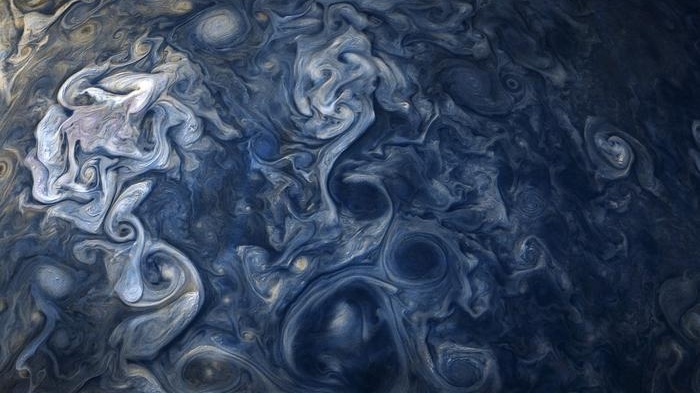Jupiter's raging gas cyclones may actually mirror Earth's oceans. Here's how
Jupiter is essentially an "ocean of gas."

How different are Jupiter's gaseous layers and Earth's oceans? Perhaps not as much as you expect.
Lia Siegelman, a physical oceanographer at the University of California, San Diego’s Scripps Institution of Oceanography, has been studying Jupiter through the lens of Earth's oceans to determine what powers the gas giant's raging cyclones. "Jupiter is basically an ocean of gas," she said in a statement.
Related: During the solar system's chaotic era, Jupiter may have helped form Earth's moon
Siegelman's original research, published in 2022, demonstrated that Jovian cyclones are powered by convection much in the same way Earth's storms are. Following up on that study, she and her team are now analyzing filaments, or "wispy tendrils" found between the Jupiter's vortices, seen in satellite imagery of the gas giant taken by NASA's Juno spacecraft.
Calculating the horizontal wind speed of the world's clouds and filaments through an analysis of infrared images, Siegelman noticed that the filaments appeared to behave similarly to fronts in Earth's ocean and atmosphere, like cold fronts or storm fronts. These fronts represent a boundary between masses with different densities (on Earth, that's usually dependent on temperature of the atmosphere and salinity of the ocean). Fronts are typically associated with strong winds or currents along their edges, which could help power Jupiter's cyclones.
The team then used methods from oceanography and atmospheric science to calculate the vertical wind speeds of the filaments, which confirmed the similarity in behavior between Earth-based fronts and Jovian ones. Through this process, the team determined that the filaments help transport heat energy from Jupiter's interior to its upper atmosphere, thus contributing to approximately "a quarter of the total kinetic energy powering Jupiter’s cyclones and forty percent of the vertical heat transport," per the statement.
"It's fascinating that fronts and convection are present and influential on Earth and Jupiter — it suggests that these processes may also be present on other turbulent fluid bodies in the universe,” said Siegelman. "There is some cosmic beauty in finding out that these physical mechanisms on Earth exist on other faraway planets."
Get the Space.com Newsletter
Breaking space news, the latest updates on rocket launches, skywatching events and more!
The team's research was published on June 6 in the journal Nature Physics.
Join our Space Forums to keep talking space on the latest missions, night sky and more! And if you have a news tip, correction or comment, let us know at: community@space.com.

Space.com contributing writer Stefanie Waldek is a self-taught space nerd and aviation geek who is passionate about all things spaceflight and astronomy. With a background in travel and design journalism, as well as a Bachelor of Arts degree from New York University, she specializes in the budding space tourism industry and Earth-based astrotourism. In her free time, you can find her watching rocket launches or looking up at the stars, wondering what is out there. Learn more about her work at www.stefaniewaldek.com.









